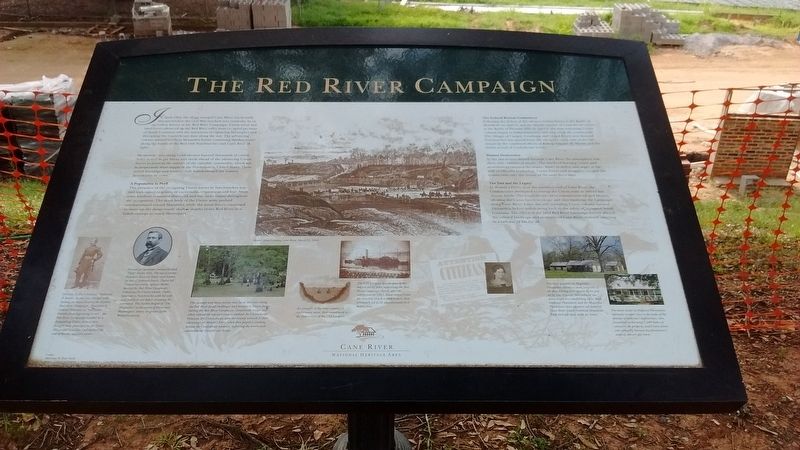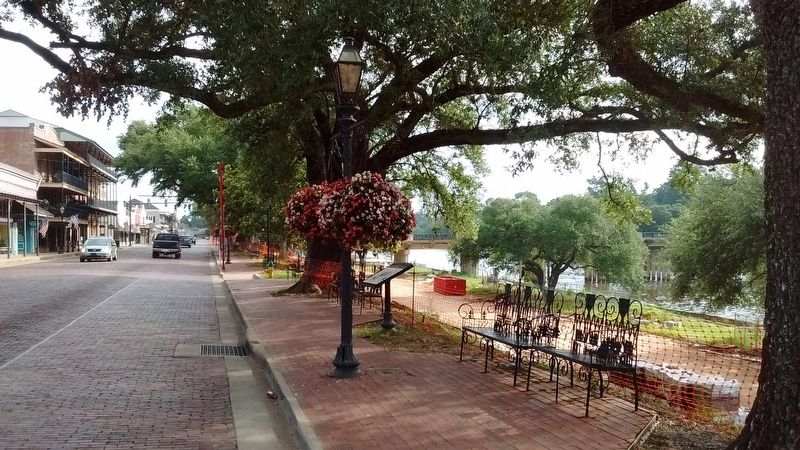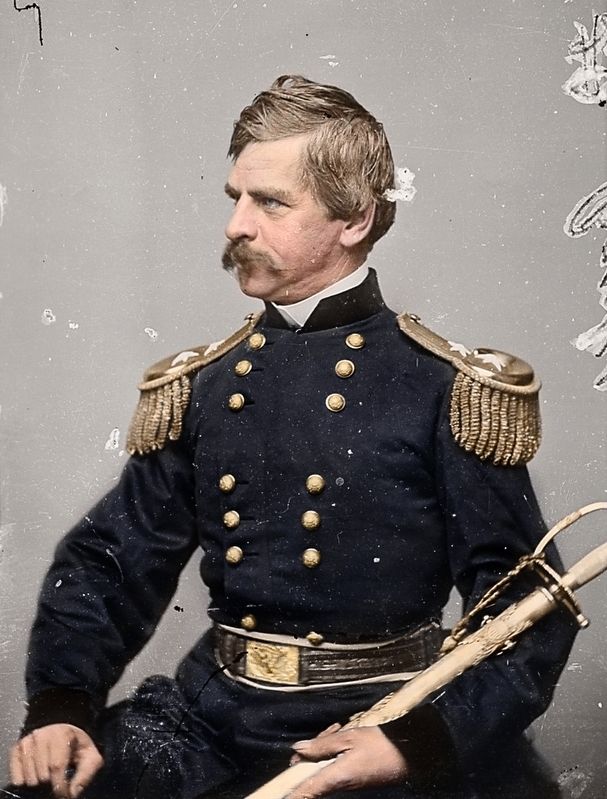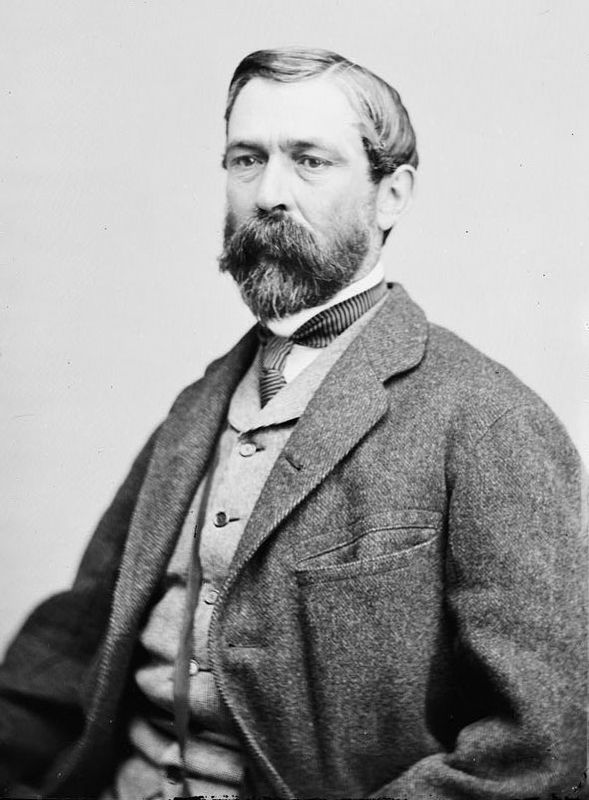Natchitoches in Natchitoches Parish, Louisiana — The American South (West South Central)
The Red River Campaign
Meanwhile, retreating Confederate burned thousands of cotton bales stored in gin barns and sheds ahead of the advancing Union forces to prevent the seizure of the valuable commodity, which was in desperately short supply in the Northeastern United States. These initial burnings and seizures only foreshadowed the wanton destruction to come.
A Population in Peril
The presence of the occupying Union forces in Natchitoches was met with mixed reactions of excitement, resentment and fear. Many town windows remained shuttered and balconies empty throughout the occupation. The main body of the Union army pushed northwestward toward Mansfield, while the naval forces continued to move up the dangerously shallow depths of the Red River in a failed attempt to reach Shreveport.
The Federal Retreat Commences
Following the defeat of the advance Union forces at the Battle of Mansfield on April 8, and the bloody repulse of Confederate forces at the Battle of Pleasant Hill on April 9, the now retreating Union column began to indiscriminately sack and torch the countryside. The villages of Campti, Coushatta and Grand Ecore were burned. Natchitoches was spared from the avenger’s torch only at the last instant by the combined efforts of Bishop Auguste M. Martin and the timely arrival of Confederate forces.
Wanton Destruction
As the armies moved through Cane River the atmosphere was thick with columns of smoke. The smells of burning cotton and structures permeated the senses. Bitter in defeat and angry at the lack of effective leadership, Union forces and stragglers ravaged the countryside over the course of the next three days.
The End of the Legacy
At Monett’s Ferry, near the southern end of Cane River, the Confederate attempted t entrap the Union army in a brief but chaotic battle. The Confederates were outmaneuvered and beaten, allowing the Union forces to escape and thus finalizing the Campaign along the Cane River. Later, the still retreating Union column burned Alexandria before withdrawing back to the safety of occupied South Louisiana. The effects of the 1864 Red River Campaign forever altered the cultural landscape and memories of Cane River, violently ushering in a new way of life for all.
(photo captions left to right)
Portrait of Major General Nathaniel P. Banks. Banks was charged with leading the main thrust of the ill-fated Red River Campaign. Described by General Sherman as “one damn blunder from beginning to end”, the Red River Campaign resulted in a devastating Union failure in the Trans-Mississippi to a close and marked the end of Banks’ military career.
Portrait of Lieutenant General Rickard “Dick” Taylor, CSA. The son of former President Zachary Taylor and brother-in-law of Jefferson Davis, Taylor led Confederate forces against Banks during the Red River Campaign. Following the Union retreat, Taylor returned to Natchitoches with his wife and family to rest before resuming his command. The Taylors lodged at “The Magnolias” at the corner of Pavie and Washington streets, as guests of the Welmsley family.
The swamps and dense forests that laced the route along the Red River posed challenges and benefits to Union forces during the Red River Campaign. Confederate troops and rebels utilized the natural cover to ambush the Union troops. However, the Union troops used the swamp network to their advantage at Monett’s Ferry when they forged a crossing behind the Confederate position, defeating the weary and outnumbered Confederate troops.
Banks’ Army Crossing Cane River, March 31, 1864.
An example of the rebel torpedo, or underwater mine, that contributed to the destruction of the USS Eastport. The USS Eastport became part of the federal naval force supporting the Red River Campaign shortly after its commission in 1862. Below Grand Ecore, the ironclad struck a rebel torpedo that ultimately led to its abandonment and destruction. The slave quarters at Magnolia Plantation remain a stark reminder of the past having been spared in the fire set by Union troops that reduced the main house to a smoldering ruin. Both Oakland Plantation and Magnolia Plantation slave quarters are units of Cane River Creole National Historical Park and are open daily for tours. The main house at Oakland Plantation narrowly escaped ruin in the wake of the retreats of both the Confederates, who succeeded in burning 1,000 bales of cotton on the property, and Union forces, who allegedly burned the plantation’s state-of-the-art gin bar.
Topics and series. This historical marker is listed in this topic list: War, US Civil. In addition, it is included in the Former U.S. Presidents: #12 Zachary Taylor series list. A significant historical date for this entry is March 31, 1864.
Location. 31° 45.598′ N, 93° 5.167′ W. Marker is in Natchitoches, Louisiana, in Natchitoches Parish. Marker is at the intersection of Front Street (State Highway 6) and Trudeau Street, on the right when traveling north on Front Street. Touch for map. Marker is in this post office area: Natchitoches LA 71457, United States of America. Touch for directions.
Other nearby markers. At least 8 other markers are within walking distance of this marker. Ft. St. Jean Baptiste (a few steps from this marker); Saint Denis Tomb (about 400 feet away, measured in a direct line); Great Red River Flood of 1945 (about 600 feet away); The Louisiana Purchase/El Camino Real De Los Tejas (about 600 feet away); The Legacy of Catholicism (about 600 feet away); First Mass in Natchitoches (about 600 feet away); Basilica of the Immaculate Conception (about 700 feet away); The Natchitoches Parish Old Courthouse (about 700 feet away). Touch for a list and map of all markers in Natchitoches.
Credits. This page was last revised on August 4, 2017. It was originally submitted on August 3, 2017, by Tom Bosse of Jefferson City, Tennessee. This page has been viewed 573 times since then and 46 times this year. Photos: 1, 2, 3, 4. submitted on August 3, 2017, by Tom Bosse of Jefferson City, Tennessee. • Bernard Fisher was the editor who published this page.



